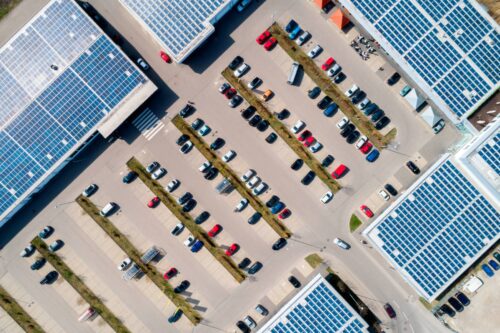
Report | 2022
Cost-Effective Grid-interactive Efficient Buildings
Decarbonization Potential for a US Retail Portfolio
Grid-interactive Efficient Buildings (GEBs) are energy-efficient buildings that optimize energy use for grid services, occupant needs and preferences, and cost reductions in a continuous and integrated way. GEBs play a critical role by bringing renewables, load flexibility measures, and energy efficiency together to reduce peak energy consumption and support a clean, resilient grid.
Through an extensive assessment of a large US retail portfolio, this new study recommends bundles of measures for optimized portfolio-wide investments and provides investment pathways to support decarbonization. A total of 113 stores were selected for the analysis across 43 states, seven climate zones, seven electricity tariff structures, and a variety of existing conditions to serve as a representative set for this specific big-box retail portfolio.
Key Findings:
- This retail chain could cut energy costs by 37 percent and carbon by 27 percent across its building portfolio of 113 stores modeled with an attractive rate of return.
- In 17 percent of the locations analyzed, it is cost-effective today to install high-efficiency heat pumps when combined with additional efficiency, demand flexibility, and rooftop solar measures.
- The retailer could shave approximately 5 MW, or 17 percent of the electricity demand across the 113 stores modeled, through new or improved demand management, efficiency, and rooftop solar measures. The potential to reduce peak demand varies by store and is driven by existing equipment and controls. Stores with electrical resistance heating can reduce peak demand by as much as 50 percent.
- Maximizing reductions in peak demand and carbon emissions while meeting investment thresholds requires location-specific retrofit packages. Stores that currently have attractive returns for heat pumps and batteries can be used as pilots for other stores that are likely to have more attractive returns in the near future.
Broader Retail Sector Insights:
The stores selected for this analysis are more efficient than 94 percent of the retail strip malls in the country. This study seeks to demonstrate how this portfolio is a model for efficient, flexible operations and, coupled with the carbon reduction findings in this report, can serve as a model for other big-box retailers.
The deployment of GEB measures was found to be economical across all tariff and climate zones and should be considered regardless of where a portfolio is located. Planning for GEB upgrades at a portfolio level will:
- Ease administrative burden
- Reduce first costs through bulk purchase agreements
- Ensure money is invested in the most lucrative projects in the portfolio
Download the report for a more detailed look at the sector-wide findings.